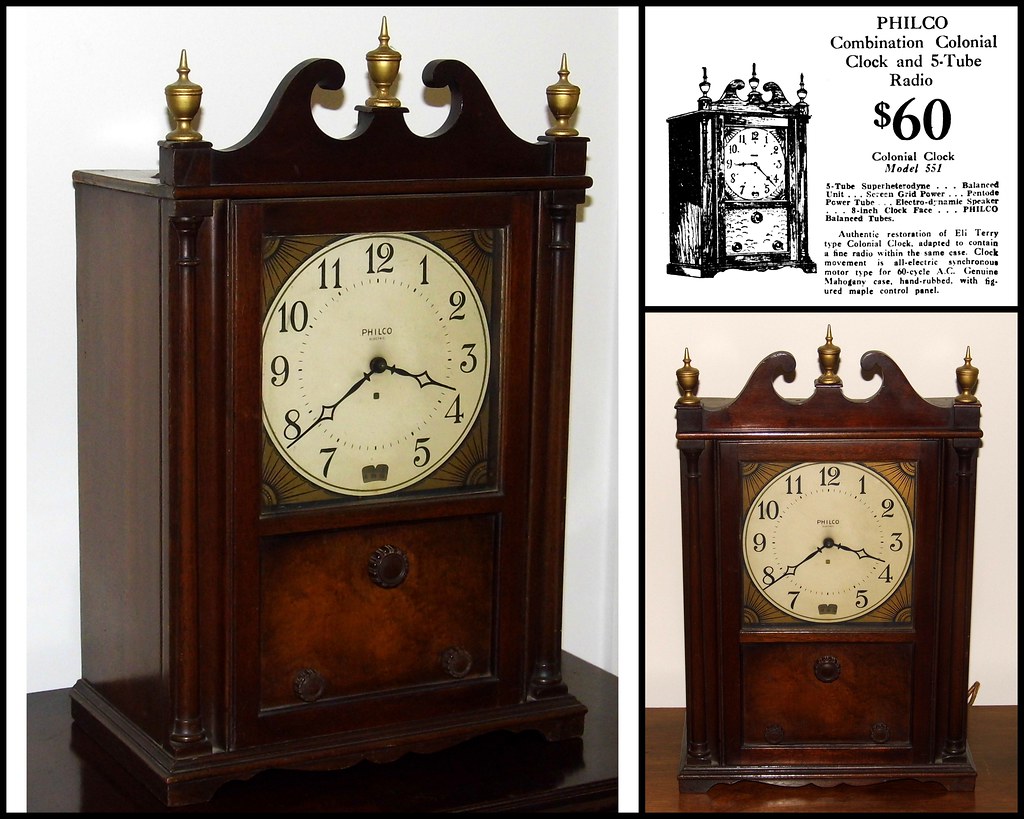#circa january 1932
Explore tagged Tumblr posts
Text
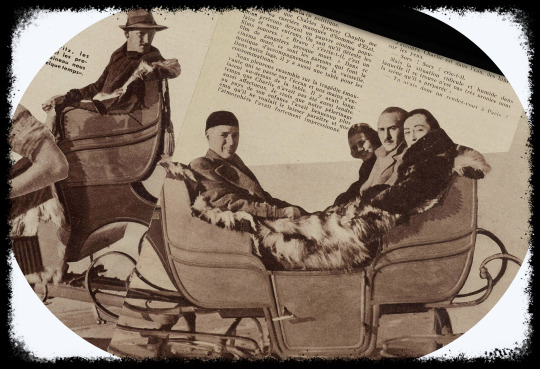
Charlie in Saint Moritz, Switzerland circa January 1932.
8 notes
·
View notes
Text
Headcanons of what years the Papas (and Sister Imperator) were born + explanation using math and Kiss the Go-Goat (please kill me)
Because I am losing my fucking mind. If any of you ever questioned my mental stability, this is the proof that I have none. - Jez
Papa Nihil - 1917
Going with the general headcanon of him dying at 103 years back in 2020, Nihil would have to be born in 1917. This would make him 52 during the Kiss the Go-Goat incident in 1969.
He would have Secondo and Terzo at 42/43, depending on the month of his birthday.
Sister Imperator - 1935
I've always assumed Nihil and her have a big age gap, considering how different their states are when they're old. She also looks really young in Kiss the Go-Goat, so I decided to go with the age her absolutely beautiful actress was back then, which is 34. This makes her 88 now.
Primo - 1932
He was said to be 80 when he left the stage in 2012, which means he would be 37 during the Kiss the Go-Goat. This also implies Nihil was 15 when Primo was born. It would mean Primo was 86 when he died.
He would also be around 27/28 when his younger brothers were born.
His age while performing would be 76 years old in the beginning and 80 in the end.
Secondo - 1959
Him and Terzo are mostly justified by the Ghostpedia than anything else. They were said to be in their late 50s/early 60s when they died in 2018. Secondo has his date of birth listed as "circa 1950s", while Terzo has his listed as "circa 1960s" despite being only three months apart. So I'm assuming he was born in like novemeber/december of 1959.
This would make him 9 during the Kiss the Go-Goat incident, seeing as it happened in September. It would also make him 58 when he died, since they died in April (aka before his birthday).
His age performing would be 53 in the beginning and 56 in the end.
Terzo - 1960
I pretty much explained everything in the note under Secondo - Ghostpedia, year of death, the three months difference between them... This makes me assume he must've been born in january/february of 1960.
Just like Secondo, this makes him 9 during Kiss the Go-Goat and 58 when he died.
His age performing would be 55 in the beginning and 57 in the end.
Copia - 1970
In Kiss the Go-Goat, we can see that it's hinted that Sister is in early stages of pregnancy in September of 1969. That would imply he was born somewhere next year, probably around June. This makes him 53 this year and 50 when he was anointed Papa.
When he started performing, he would be 48.
#ghost band#ghost bc#ghost#papa nihil#papa emeritus i#papa emeritus ii#papa emeritus iii#papa emeritus iv#sister imperator#primo#secondo#terzo#copia#cardinal copia
240 notes
·
View notes
Text
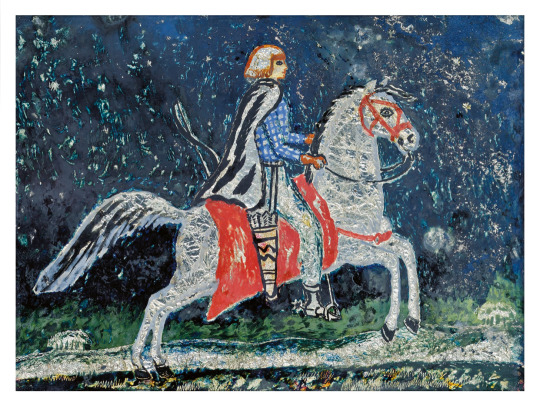
Dora Carrington (1893-1932), Iris Tree on a Horse, circa 1920s. Oil, ink, silver foil and mixed media on glass. 11 x 14 cm. The Ingram Collection of Modern British and Contemporary Art. This work is included in A Spirit Inside at The Lightbox, Woking, until 14 January 2024. Artwork: © The Estate of Dora Carrington
6 notes
·
View notes
Video
Vintage Philco Colonial Clock Radio, Model 551, Broadcast Band Only (MW), 5 Vacuum Tubes, Made In USA, Circa 1932 by Joe Haupt Via Flickr: The ad in the upper right corner is from a Hub store ad in the January 8, 1932 edition of the Evening Sun newspaper (Washington, DC).
#Vintage Philco Model 551 Colonial Clock Radio#Vintage Radio Collection#Vintage Philco Vacuum Tube Radios#1930s Radios#flickr
1 note
·
View note
Photo


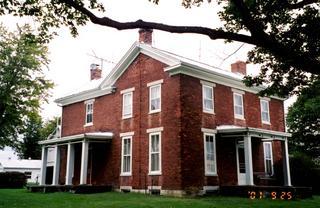



Underwood Farms Rural Historic District
State Route 73 and Brimstone Rd.
Wilmington, Ohio
The Underwood Farms Rural Historic District on Ohio Route 73 just west of Collett Road (County Route 232), near Wilmington, Ohio, in Chester Township, Clinton County, preserves 280 acres of landscapes and sixteen buildings depicting rural life in Clinton County from about 1838 to 1955. The District encompasses the Amos-Elihu-Daniel Underwood (“west brick”) and Zephaniah Underwood (“east brick”) farms, and the Zephaniah and Matilda Underwood house (the “Tower House,” circa 1884), along with the Jonah’s Run Baptist Church. The District was listed with the National Register of Historic Places on January 11, 2005,
Lewis Dakin bought this property from James Haines in 1850, and built a house known as the "west brick" or the Amos-Elihu-Daniel Underwood Farm with barn and outbuildings, soon afterward, c. 1853. Amos Underwood (1786-1867) from York County, PA, first settled in Liberty Township and then purchased this property in Chester Township, Clinton County, Ohio. The Underwoods were Hicksite Quakers attending Meeting in Harveysburg. His son Elihu continued in the farming and fruit business. His grandson Daniel married Wilhelmina Hahn in 1902, continuing the family business until his death in 1942. Underwood family members lived in this location for about 100 years.
The Underwoods were farmers and, like other farmers in the area, raised corn, oats, and wheat and had a dairy operation. They also raised chickens, pigs, and sheep. However, the Underwoods were famous for their orchards, none of which, unfortunately, have survived. Zephaniah Underwood had 70 acres of his farm in orchard with apples. The apple orchard was the central focus of the family activity on the farm and successful business. Known as the "east brick," the Zephaniah Underwood Farm (James Dakin House) with barn and outbuildings, was built around 1846-1850. It is a two-story five-bay brick Federal style house with a two story ell. Directly behind it is a historic fruit barn that was associated with the Underwood Orchards.
The Underwoods were famous for their commercial apple orchards, although like other farmers raised a variety of crops and livestock. Tower House Farm, or "The Zephaniah and Matilda Underwood House," with barn and outbuildings, built between 1884 and 1886, is an excellent example of the "Stick Style.” The Zephaniah and Matilda Underwood farm includes a circa 1900 brick fruit storage building, insulated by sawdust. The Underwoods were leaders in other areas. Matilda Downing Underwood (1851-1932) was a Quaker minister and active in the temperance and women’s suffrage movements. Matilda’s sister, Maria Downing Romine (1848-1922), was a medical doctor, a pioneering career for women of her time.
The Underwoods were active members of The Society of Friends (Hicksite). They attended Grove Meeting in Harveysburg, a meeting that was a Preparative Meeting of Miami Monthly Meeting in Waynesville. Both Zephaniah and Matilda Underwood were active supporters of Quaker meeting and issues such as temperance and suffrage. Matilda Downing Underwood was a recognized minister in Grove Meeting of Friends. She was also an author. She wrote: Blue Bell of the Forest: A Story of the Olden Time, in the Middle West (published by the author in 1919) and her Autobiography (unpublished).
0 notes
Text





Various close-ups from Maria and younger sister Consuelo pictured, according to Margarita Vicens, in 1934. If the date given is correct (which I assume it is), Maria would be 22, and her sister Consuelo (according to Maria, she was born in 1925) would be 9 years old!! which is clearly impossible!! I think Consuelo is a teenager here.
It's interesting to note that in Margarita Vicens book "María Montez, Su vida", the sibligs are listed as follows:
Isidoro Rafael - the firstborn
María África
Aquilino Mario
Joaquín David
Ada
Consuelo
Luz
Luis Antonio
Jaime Enrique
Teresita
In Antonio Pérez Arnay's book "María Montez La Reina del Technicolor", the siblings are listed as it follows:
Isidoro Rafael (3rd April, 1911)
María África (6th June 1912)
Aquilino Mario (14th May 1914)
Joaquín David (26th August 1915)
Ada
Consuelo
Luz
Luis Antonio (10th June 1923)
Jaime Enrique (24th August 1925)
Teresita (1932)
So Ada, Consuelo and Luz have no birthdates in neither of these two books.

Jaime is listed he was born in 1925 in Antonio Perez Arnay's book while Margarita says in her book that Jaime passed away in 1979 aged 51, that would meant he was born in 1927 or 1928, so the date given in the book doesn't fit, but if you go to GENI Family tree site, you'll find he was born the 28th September 1927 and I do really believe this is the correct date of his birthday since the person who admins his profile at this website is surnamed Pombrol, and The Pombrols are distant cousins from The Gracias.

With Teresita we have a similar "problem", in Antonio's book it's written she was born in 1932 but she passed away in January 2023 aged 93, so it's very probably she was born in 1929 rather in 1930.

About Lucita, we have a similar problem... in Margarita Vicens book it says she passed away in 1979 due to a cancer, but there is no information about her birth date, I've read in some sources that she was born in 1929. If you look at her pictures, she looks very young, even younger than her sister Teresita!! but we all know and agree that Teresita is the youngest one, so it's very likely that Lucita was born in 1926.

Now here it comes very interesting information about Adita. According to GENI, Adita was born the 24th December 1924, in 1946 she was 22 years old (that's a fact) and she was married twice! She got married the 11th May 1957 with Otto R. Nemeth, when she was 32 years old. When she passed away, the 8th February 1993, she was Ada Teresa Thomas. It's not known if she had any children.

So as you can see, Consuelo couldn't be born in 1925, my guessing is that she was born circa 1917, so in that photo she was 17 years old. That would make so much sense.
So the updated list would be as follows:
Isidoro Rafael (3rd April, 1911)
María África (6th June 1912)
Aquilino Mario (14th May 1914)
Joaquín David (26th August 1915)
Consuelo (1917 ?)
Luis Antonio (10th June 1923)
Ada Teresa (24th December 1924)
Luz (1926 ?)
Jaime Enrique (28th September 1927)
Teresita (1929 ?)
My dream is to find the Gracia Vidal siblings birthdates, so if there is someone from Barahona here and can access the birth certificates or the baptism registries, your help will be much welcomed, appreciated and credited, of course!!
Remember that this site is made from love and respect and if I would like to have their birthdates is because I want to honour them for their birthday.
Thank you so much!!
Eleni xoxoxo
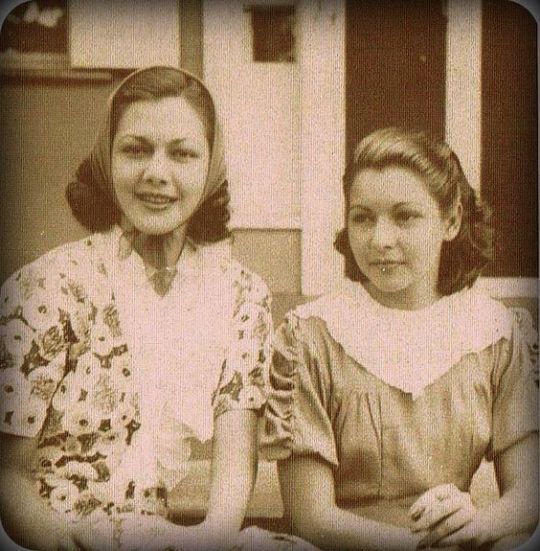
María África Gracia Vidal (on screen she will became Maria Montez) pictured with her younger sister Consuelo in Barahona, Dominican Republic in 1934.
This photo comes from Pinterest but it has been printed in Margarita Vicens book "María Montez, Su vida - edición especial del Centenario" (Dirección General de Cine de la República Dominicana, 2012.
#Maria Montez#María Montez#Consuelo Gracia Vidal#1934 Maria#1934 Consuelo#Gracia Family#Montez Family#finding birthdates#Isidoro Rafael Gracia Vidal#Aquilino Mario Gracia Vidal#Joaquin David Gracia Vidal#Ada Gracia Vidal#Lucita Gracia Vidal#Luis Antonio Gracia Vidal#Jaime Enrique Gracia Vidal#Teresita Montez#siblings#Montez Siblings#Gracia Siglings#GENI
19 notes
·
View notes
Text
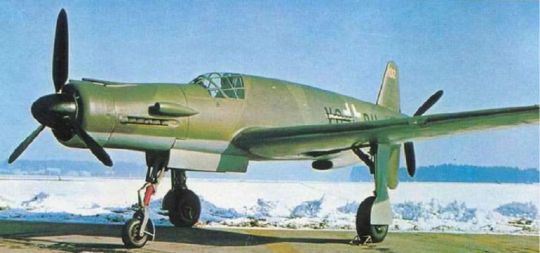
-A Dornier Do 335 Pfeil on a snowy runway, some time in 1944 or '45. | Photo: Luftwaffe
FLIGHTLINE: 181 - DORNIER DO 335 PFEIL ("ARROW")
Initially designed in response to a request for a Schnellbomber, the Do 335 was reconfigured into a multi-role aircraft, though only a few were completed before Germany surrendered.
Claude Dornier founded the Dornier Flugzeugwerke ("Aircraft factory") in 1914, and was renowned for building large, all-metal flying boats as well as land-based passenger aircraft between the Great War and WWII. These included the record-breaking Do 16 Wal ("Whale") of 1924, the Do X of 1929, and the Komet ("Comet") and Merkur ("Mercury"), a favorite of Lufthansa and SCADTA in Colombia, as well as several South American militaries. A feature of many Dornier aircraft were tandem engines, a tractor and a pusher motor placed back to back. This arrangement allowed an aircraft to enjoy the extra power of having multiple engines without the associated drag of having multiple tractor installations. It also alleviated the issue of asymmetric thrust in case of an engine failure.

-A Do X in flight, circa January 1932. This was one of a number of Dornier flying boats to have a tandem engine configuration. | Photo: German Federal Archives
DEUTSCHLAND PFEILE
What became the Do 335 originated in 1939, while Dornier was working on the P.59 Schellbomber ("high-speed bomber"), which would have carried and equivalent load to a Ju 88 or Me 410, but featured a tandem engine arrangement. Work on the P.59 was cancelled in 1940, but Dornier had already commissioned a test aircraft, the Göppingen Gö 9, to test the feasibility of connecting a pusher prop via an extended drive shaft. The Go 9 was based on the Do 17 bomber, but scaled down 40% and with a cruciform tail. The test plane validated Dornier's designs, though the eventual fate of the Go 9 is not known (likely though, it was destroyed by Allied bombing or recycled).
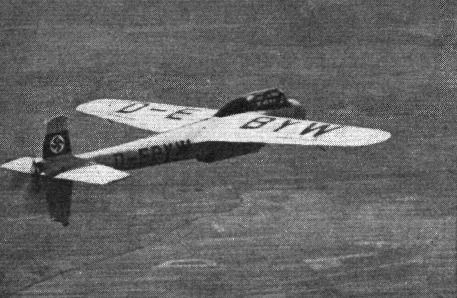
-The Göppingen Gö-9 motor glider, designed by Wolf Hirth. flying c.1941. | Photo: Flightglobal
The P.59's general design was resurrected in 1942 when the RLM requested a high-speed bomber with a 1,000kg payload. Dornier submission, designated the P.231, was awarded a development contract and the model number Do 335. Late in 1942, the requirements were changed from a Schnellbomber to a multirole fighter, which resulted in extensive delays while the designs were updated.
FLUGZEUGSPEZIFIKATIONEN
The Do 335 was 13.85m long, with a wingspan of 13.8m and a height of 5m. Empty, the plane weighed 7,260kg, while at max TO the weight was 9,600kg (10,000kg for the two-seat trainers and night fighter variants). Power was provided by two Daimler-Benz DB 603E-1 liquid-cooled V-12s developing 1,324kW each. Due to the situation in late-war Germany, the engines were fitted to run on 87 octane "B4" lignite-derived synthetic fuel, and MW50 boost was also available for additional speed. The basic fighter/bomber variant was armed with a singe 30mm MK 103 cannon firing through the spinner and two 20mm MG 151/20 autocannon mounted in the front engine cowl and synchronized to fire through the prop disc. A single 500kg bomb could be carried internally, and two pylons on the wings could be fitted with bombs, gun pods or drop tanks, with a total load of 100kg. During flight tests, the Do 335 hit 763kmh with boost (686kmh without), making it the fastest production fighter the Luftwaffe fielded during WWII. Under single-engine operations, the plane could still fly at 563kmh. Service ceiling was 11,400m, and under ideal conditions the plane could climb to 8,000m in 14 minutes 30 seconds. Due to concerns over a pilot striking the dorsal fin or the rear prop (a common concern in pusher designs before ejector seats became common), explosive charges would sever the fin and propeller before the pilot would bail out.

-Orthograph of the Do 335 A-1. | Illustration: Richard Ferriere

-Cutaway drawing of the Pfeil showing the engines, linkages, and landing gear actuators. | Illustration: Dornier

-Mounting locations of the 335's guns and associated equipment. | Illustration: Dornier
Maiden flight of the Do 335 V1 prototype was on 26 October 1943. A total of 27 flights were made with the V1, which uncovered a weakness in the landing gear, and issues with the main landing gear wheel-well doors saw them removed for the majority of the flights. The second aircraft, V2, first flew on 31 December 1943, and featured uprated DB 603A-2 engines as well as aerodynamic changes informed by the V1's test flights as well as wind tunnel tests. Maiden flight of the V3 pre-production aircraft was on 20 January 1944, which was fitted with DB 603G-0 engines, which produced 1,400kW at take off. The V3 was also fitted with two rear-view mirrors, alleviating blind spots caused by the location of the aft engine. A total of ten preproduction aircraft were then ordered, and in January the RLM ordered five more prototypes of the night fighter variant, later designated the A-6. By war's end, at least 16 prototypes of the Do 335 and related programs had flown, accumulating some 60 flight hours.

-The Do 335 V1 during testing in 1943 or '44. | Photo: Luftwaffe
Production of the Do 335 was given maximum priority under Hitler's Jägernotprogramm (Emergency Fighter Program), issued on 23 May 1944, and the competing He 219 Uhu ("eagle-owl") Nachtjäger theoretically freed up needed DB 603 engines for the Pfeil, but in practice Heinkel continued production of the 219A. Dornier's factories in Friedrichshafen and Munchen were anticipated to produce 120 and 2,000 Do 335s, of various configurations, by March 1946, but an Allied attack on Friedrichshafen destroyed tooling for the Pfeil, which resulted in a new line being set up in Oberpfaffenhofen. The first preproduction Do 335 A-0 model was delivered in July 1944, and construction of the first production A-1 model began in late 1944. As the war progressed, various models of the Do 335 proliferated (as happened often with late-war aircraft programs) as the Nazis sought to turn back the Allied forces:
Do 335 A-2: single-seat fighter-bomber aircraft with new weapon sights, later proposed longer wing and updated 1,471 kW (1,973 hp) DB603L engines.
Do 335 A-3: single-seat reconnaissance aircraft built from A-1 aircraft, later proposed with longer wing.
Do 335 A-4: single-seat reconnaissance aircraft with smaller cameras than the A-3
Do 335 A-5: single-seat night fighter aircraft, later night and bad weather fighter with enlarged wing and DB603L engines.
Do 335 A-6: two-seat night fighter aircraft, with completely separate second cockpit located above and behind the original.
Do 335 A-7: A-6 with longer wing.
Do 335 A-8: A-4 fitted with longer wing.
Do 335 A-9: A-4 fitted with longer wing, DB603L engines and pressurized cockpit.
Do 335 A-11/12: A-0 refitted with a second cockpit to serve as trainers.

-A Do 335 A-12 trainer, known as the Ameisenbär ("anteater"), late in the war. | Photo: Luftwaffe
Do 335 B-1: abandoned in development.
Do 335 B-2: single-seat destroyer aircraft. Fitted with 2 additional MK 103 in the wings and provision to carry two standard Luftwaffe 300 litre (80 US gal) drop tanks.
Do 335 B-3: updated B-1 but with longer wing.
Do 335 B-4: update of the B-1 with longer wing, DB603L engine.
Do 335 B-6: night fighter.
Do 335 B-12: dual-seat trainer version for the B-series aircraft.
Do 435: a Do 335 with the redesigned, longer wing. Allied intelligence reports from early May 1945 mention spotting a Do 435 at the Dornier factory airfield at Lowenthal.
Do 535: actually the He 535, once the Dornier P254 design was handed over to Heinkel in October 1944; fitted with jet engine in place of rear piston engine.
Do 635: twin-fuselaged long-range reconnaissance version. Also called Junkers Ju 635 or Do 335Z. Mock up only.
P 256: turbojet nightfighter version, with two podded HeS 011 turbojet engines; based on Do 335 airframe.
In April 1945 the Allies captured the Oberpfaffenhofen factory in late April 1945, capturing 11 A-1 fighter/bombers and 2 A-12 trainers. That same month, a flight of four RAF Hawker Tempests, led by French ace Pierre Clostermann, encountered an unknown model of Do 335 over northern Germany at low altitude. The Pfeil pilot began evasive maneuvers, but Clostermann opted to not give chase as the enemy plane displayed superior speed. At the time of the German capitulation in 1945, 22 Do 335A-0, A-1 and A-11/12 aircraft were known to have been completed.

-Dornier Do 335 aircraft on the runway at Oberpfaffenhofen just after the end of the Second World War. | Photo: USAAF

-A Do 335 after being captured by the US, with American markings painted over the Luftwaffe ones. | Photo: Charles Daniels Collection/SDASM Archives
At least two Do 335s were brought to the US under Operation LUSTY, with one, Do 335 A-0, designated A-02, with construction number (Werknummer) 240 102, and Stammkennzeichen ("factory radio code registration") VG+PH being claimed by the Navy for testing. The aircraft was transported on HMS Reaper along with other captured German aircraft, then shipped to the Navy's Test and Evaluation center at NAS Pax River. Another Pfeil was tested by the USAAF at Freeman Field in Indiana, but nothing is known about its fate. In 1961 VG+PH was transferred to the Smithsonian Institution, though it remained outside at NAS Oceana until 1974, when it was shipped back to the Dornier factory in Oberpfaffenhofen for restoration. Over the next year, volunteers from Dornier (some of whom worked on the aircraft originally) found that the explosive charges meant to sever the tail and aft prop were still installed and live, thirty years later. After work was completed the aircraft was placed on display at the Hannover Airshow from 1 to 9 May 1976, and afterwards it was on loan to the Deutsches Museum until 1988. The aircraft was shipped back the States after that, and is now on display at the Udvar-Hazy Center along with other German aircraft brought over during Lusty like the only known Ar 234 Blitz jet bomber and the partially restored He 219A Uhu.
#aircraft#aviation#avgeek#airplanes#airplane#aviation history#ww2 history#ww2 german aircraft#ww2 aircraft#ww2#ww 2 aircraft#ww 2#wwii history#wwii aircraft#wwiii#ww ii#ww ii aircraft#secret project#secret weapons of the Luftwaffe#luftwaffe#wonder weapons
39 notes
·
View notes
Text
Clara Wolcott Driscoll: Tiffany Studios’ Brightest Light
“This is rather difficult work, but when one has a fondness for a certain brand of industry, she does not pause when a difficulty must be overcome.” -- Clara Wolcott Driscoll
This past summer the Munson Williams Proctor Museum in Utica, NY held an exhibition, “Louis Comfort Tiffany: Treasures from the Driehaus Collection.” The astonishing show featured Tiffany’s most iconic lamps, many designed by a woman whose name is largely forgotten now, Clara Wolcott Driscoll. The women who assembled Mrs. Driscoll’s designs were popularly referred to as “Tiffany Girls,”(1), and they worked under her in Tiffany’s Women's Glass Cutting Department. Driscoll was the designer behind many of the best well-known lamps to emerge from Tiffany Studios: Daffodil, Wisteria, Dragonfly, and Peony lamps (2).

Clara Wolcott Driscoll for Tiffany Studios (1900), Daffodil Shade (detail). Photo credit: Telome4 - Own work, CC BY-SA 3.0, https://commons.wikimedia.org/w/index.php?curid=14892217 Image source.
Young Clara Pierce Wolcott
Clara Pierce Wolcott was born in Talmadge, Ohio in 1861. Her father, Elizur V. Wolcott studied theology and aspired to be a missionary but his poor health prevented that dream from becoming a reality. Instead, Wolcott became a farmer and teacher (3). Tragically, Wolcott died in 1873, forcing his wife Fannie to find work as a teacher in order to support Clara and her three younger sisters (3). Fannie Wolcott who had attended the Talmadge Academy was determined that her daughters would also receive an education. With her family connections, Fannie placed “Clara with relatives living near the excellent (and free) Central High School”(3) in Cleveland, Ohio.
During her time at Central High School, young Clara demonstrated a keen interest in the natural world, especially flowers. This interest was undoubtedly encouraged by naturalist, Harriet Louise Keeler who was an instructor at the school during that time (3). After graduation, Clara enrolled in “the Western Reserve School of Design for Women (now the Cleveland Institute of Art)”(2). Not much, however, is known about Clara’s time there.
Sometime after Clara’s secondary studies were completed, she had “taken a position as designer for C. S. Ransom and Company, a Cleveland-based manufacturer of Moorish-influenced fretwork panels”(3).
Clara Driscoll Joins, Departs and then Rejoins Tiffany Studios
In the fall of 1888, Clara left Cleveland and headed to New York City to continue her art education “at the then-new Metropolitan Museum Art School” (2). Not long after her arrival in New York Louis Comfort Tiffany hired her as a designer in his studio. At Tiffany Studios Clara “earned the intricacies of glass selection and cutting,”(3) but after only a year with Tiffany, Clara left to get married as was the law in New York at that time. In 1989, Clara married Francis Driscoll who was thirty years her senior. In 1892 Mr. Driscoll died, and Clara, widowed, was rehired by Tiffany. Soon after Tiffany named Clara to head the Women’s Glasscutting Department (3). She had excellent managerial skills with an aptitude “for realizing a great profit from lamps and fancy goods”(4). When Clara took over the glasscutting department six women were working under her, eventually the staff would grow to thirty-five strong. These women earned the nickname “The Tiffany Girls”(5).

Clara Wolcott Driscoll (third row far left, wearing a white blouse) and the “Tiffany Girls” (circa 1904). Photo courtesy of The Charles Hosmer Morse Museum of Art.
Challenges Faced by Clara Driscoll and the Women Working at Tiffany Studios
The women in her department selected the glass for the shades, “cutting the individual segments using templates, and wrapping them with copper foil”(5). The men would assemble the lamps by attaching the glass pieces to molds and soldering the copper foil edges together.
Over time rivalries developed between the men and the women workers. Men were “making windows, mosaics, and leaded shades” while the women for a time were relegated to only glass cutting. The men belonged to a union that “did not admit women,” so the women could not enjoy the same benefits as the men. Tiffany, however, paid his male and female employees equally which angered many of the men (5). “In 1903, the men threatened to strike in order to take away the women’s right to make windows”(5). Tiffany refused to meet the union’s demands but agreed to limit “the number of women in Driscoll’s department at 27”(5).
Mrs. Driscoll, herself became frustrated with faced staffing issues in the Women’s Glasscutting Department. Since married women were barred from employment Driscoll, would invest in developing a young talent only to lose the young woman to the wedding altar (5).
Clara’s Mystery Engagement
Mrs. Driscoll had also considered remarrying sometime between 1896 and 1897; she became engaged to Edwin Waldo the brother of artist George B. Waldo, one of Driscoll’s friends. While on route to meet his potential future in-laws in Ohio, Edwin inexplicably disappeared. No one heard from him for five years. Possibly due to the painful nature of this episode, Mrs. Driscoll never referred to it in any of her writings (3).
Clara Driscoll’s Major Works for Tiffany
During 1896 “Clara began experimenting with lamps”(5). Along with “Tiffany designer Agnes Northrop and fellow Cleveland art school classmate Alice Carmen Gouvy (also hired by Tiffany), Mrs. Driscoll designed the innovative Flying Fish lamp and Deep Sea mosaic and glass-jeweled base”(2). In addition to lamps, she designed “desk and boudoir accessories, often in combinations of glass, bronze, and mosaic”(3).
Driscoll drew her inspiration for her iconic lamp designs upon her life-long passion for and study of nature. Based upon information Driscoll shared in one of her letters, the daffodil lamp was her first important lamp design in 1900. That same year her design for the dragonfly lamp, “won a prize at the 1900 World’s Fair,”(6) that design, however, had long been credited to her boss, Louis Comfort Tiffany (6). The stunning wisteria lamp has also been attributed to Clara (5).
Clara Driscoll’s Later Years
In 1909 Driscoll left Tiffany Studio for the final time to marry Edwin Booth. While marriage ended Mrs. Driscoll’s professional career, she continued designing -- this time the product was colorful silk scarves. Edwin retired from his job managing an import business in 1929 just as the Great Depression struck, and the couple spent the remainder of their years in Florida. Their marriage would last thirty-five years until Clara’s death in 1944 (3).
Clara Driscoll’s Design Legacy
Clara Driscoll’s real role in Tiffany Studios went largely forgotten. When the company folded “in 1932, all the records were lost”(1). In 1953 when her sister Emily died, a trove of letters between the two sisters was discovered. It was not until almost 40 years later, however, that the letters were recognized by scholars when one of Driscoll’s relatives “Elizabeth A. Jones Yeargin transcribed a sampling from the letters for her work…self-published as a bound typescript titled The Pierce and Wolcott Letters”(3).
During Clara Driscoll’s career about thirty “or so lamps believed to have been designed by or created under”(6) her direction. These included “the Wisteria, Dragonfly, Peony, and from all accounts, her first — the Daffodil”(2). One Wisteria Lamp sold for $492,500 on December 14, 2017, at Christie’s in New York (7). Driscoll’s lamps are held in the collections in the Metropolitan Museum of Art in New York and in numerous museums throughout the world. In recent years, numerous exhibitions of Tiffany lamps that featured Driscoll’s works, like the recent show in Utica, NY, have been held. The first to specifically acknowledge her contributions to Tiffany Studios was the New-York Historical Society 2007 show, “A New Light on Tiffany: Clara Driscoll and the Tiffany Girls.” Also that year, a book of the same title by Martin Eidelberg, Nina Gray and Margaret Hofer was published, and in 2011 Susan Vreeland published her historical novel Clara and Mr. Tiffany, based on the relationship between Mrs. Driscoll and Louis Comfort Tiffany (1). It may have been a long time coming, but the world is beginning to recognize the design genius of Clara Wolcott Driscoll.
References
Taylor, K., (13 February 2007). “Tiffany's Secret Is Over,” The New York Sun website. https://www.nysun.com/arts/tiffanys-secret-is-over/48495/
Wikipedia, (29 May 2019). Clara Driscoll (glass designer). https://en.wikipedia.org/wiki/Clara_Driscoll_(glass_designer)
Bassett, M., (1 January 2012). “Breaking Tiffany's Glass Ceiling: Clara Wolcott Driscoll (1861-1944),” Cleveland Institute of Art website. https://www.cia.edu/news/stories/breaking-tiffanys-glass-ceiling-clara-wolcott-driscoll-1861-1944
The Charles Hosmer Morse Museum of American Art (2019). “Tiffany Studio Designers,” The Charles Hosmer Morse Museum of American Art website http://www.morsemuseum.org/louis-comfort-tiffany/tiffany-studios-designers
Gedal, A., (27 March 2015). “Clara Driscoll and the Tiffany Girls,” The New York Historical Society and Museum website http://behindthescenes.nyhistory.org/tiffany-girls/
Kastner, J., (25 February 2007). “Out of Tiffany’s Shadow, a Woman of Light,” New York Times Online Archives. https://www.nytimes.com/2007/02/25/arts/design/25kast.html?pagewanted=print
Vilinsky, B., (9 August 2019). “Collecting Guide: 10 Things to Know About Tiffany Lamps,” Christie’s website. https://www.christies.com/features/Tiffany-lamps-10-things-you-need-to-know-9542-3.aspx
1 note
·
View note
Text

Patrick Gibson House
706 East Leigh Street
Built, circa 1796
Demolished, 1931

[HOR] — 706 East Leigh Street
Wait, a second. Isn’t this the “Pin Money” Pickles factory? Yes, in fact, it is! Sometimes a location has more than one story to tell about it.

(Library of Congress) — Sanborn Fire Insurance Map from Richmond (1905) — Plate 72 — showing the factory location of “Pin Money” Pickles
It seems probably that Mordecai was correct in saying that this house was built by Joseph Jackson. Jackson bought the square on January 3, 1795 from the administrators of Patrick Coutts, and while the deed mentions “all Houses, buildings . . . ” the price, 36 pounds, could hardly have included a two-story brick dwelling. As the value of the property was increased the following year it would seem that Jackson built the house almost immediately. He soon put a mortgage on the property, and in May. 1798 it was purchased at auction by Thomas Rutherfoord. The greatly increased price, 1075 pounds, again confirms the hypothesis that Jackson built the house.
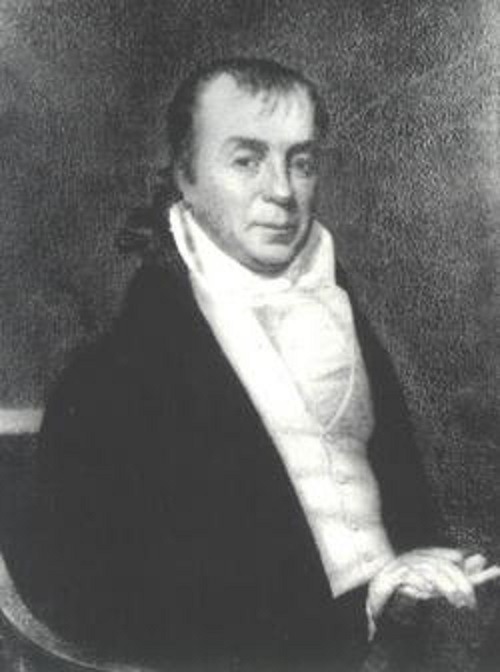
(Find A Grave) — Thomas Rutherfoord
In his unpublished memoir, Rutherfoord gives a curious sidelight on this transaction. Jackson had come to his assistance when Mr. Rutherfoord broke his leg while crossing what is now the square between Main, Franklin. Sixth, and Seventh Streets on a dark night. He returned Jackson’s kindness by buying this house and the land later called Jackson’s Addition but was eventually disillusioned about the young man and tried to save something from the wreck of his affairs for his children. Rutherfoord held the house only two years. In April, 1802 it was first insured, the owner at that time being Bartlett Still, who sold it the following year to Patrick Gibson.

(Speak, Memory: Time Regained) — print of the Richmond Theatre fire of 1811 — Alexander W. Weddell, Richmond, Virginia, in Old Prints. 1737-1887 (Richmond, 1932), plate 12
Mordecai describes Patrick Gibson “as respectable merchant, connected in business with a nephew of Mr. Jefferson.” This seems unflattering for the ancestor of some of Virginia’s most distinguished citizens, until one remembers that the word “respectable’’ was purely laudatory in connotation until long after Mordecai’s book was written. In the Theatre Fire of 1811 not only Gibson’s first wife but a girl who lived with the Gibsons, Nancy Green, whose parents were actors, perished.
Gibson, who had just returned from a trip abroad, escaped the fire and lived to marry again and have a number of children by his second wife.
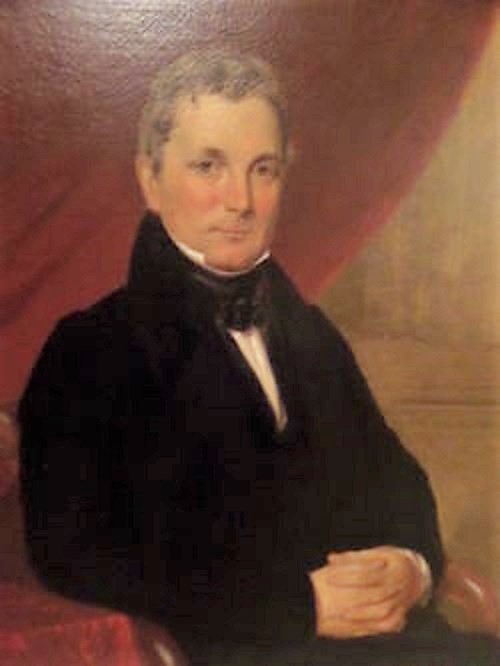
(Find A Grave) — Nicholas Mills
In 1823, when Gibson’s affairs were embarrassed, the house had been bought by his second wife’s aunt, Mrs. Martha Jones. That Mrs. Jones was revered as the good angel of the household is evidenced by the fact that two of the Gibson children were named for her two successive husbands! After Patrick Gibson’s death she sold the property, in 1828, to Nicholas Mills.
Immediately after his death the whole block from Seventh to Eighth was sold to William Allen of Surry County for $76,244 (Confederate). During the ’seventies the house was occupied by J. W. Cringan and later by the St. Paul’s Church Home for aged women. In 1882 William J. Johnson, who had meantime bought a part of the property, including the house, sold it to Everard B. Meade. During Mr. and Mrs. Meade’s occupancy, which lasted until 1898, the old house had another renascence as the centre for a lively group of young people, who called themselves Mrs. Meade’s “chickens.” The gay foolishness centering around the house at that time has recently been recalled in a pamphlet written by one of those who enjoyed it.

(Facebook) — Mrs. Ellen G. Kidd, proprietor of “Pin Money Pickles “
In 1898 the house was sold to Mrs. Ellen G. Kidd. In a building in the rear Mrs. Kidd began her experiments in cookery which resulted in the famous “Mrs. Kidd’s Pin-Money Pickles.” She owned the house up to 1922, though the pickle-factory had long since moved to larger quarters. After that the property was very run down and was rented to a low class of Negroes. In 1931 the house was demolished.

(Souvenir Views Negro Enterprises and Residences, Richmond, Va) — Y. M. C. A. Rev. S. C. Burrell, Sec’y.
The many outbuildings which had belonged to the place in Gibson’s day had long since disappeared, the block being closely built up. The house itself was probably very little changed. It had a wing which was added sometime before 1811 and a charming two story porch, unique in Richmond, of which the date is unknown, since it is not shown on the insurance policies. The interior woodwork, which was bought by the Richmond Art Company, was beautiful, especially the mantels and an arch across the hall.

March 2019 — looking towards 706 East Leigh Street today
Mary Wingfield Scott: a woman of opinions.
As an architectural historian, her two volumes on Richmond houses are priceless, but some of the racist things she says in them are truly cringe-worthy. When she says that it was rented to a low class of Negros, she really means that it was used as the Jackson Ward YMCA. Her comment added nothing to the narrative, and yet she had to say it. Makes you shake your head.
(Patrick Gibson House is part of the Atlas RVA! Project)
Print Sources
[HOR] Houses of Old Richmond. Mary Wingfield Scott. 1941.
2 notes
·
View notes
Text
Closer, January 28
Cover: Gregory Peck’s Amazing Untold Story

Page 1: Contents, What I’ve Learned -- Carol Burnett, Joke of the Week -- Bill Murray
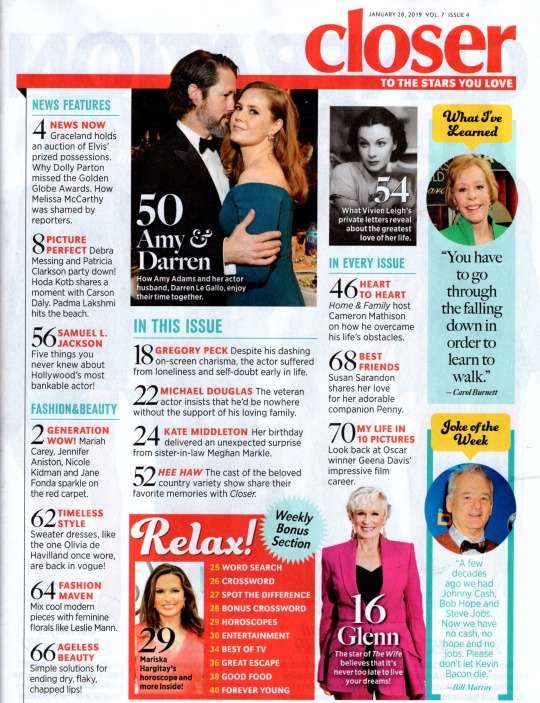
Page 2: Generation Wow -- Sequins -- Heidi Klum, Mariah Carey, Judith Light, Jennifer Aniston
Page 3: Allison Janney, Rachel Zoe, Nicole Kidman, Jane Fonda
Page 4: Elvis Presley’s prized personal items went up for auction
Page 5: Melissa McCarthy getting the last laugh on fat shamers in the media, Dolly Parton missed the Golden Globes because of health issues in her family
Page 6: Hellos & Goodbyes
Page 8: Picture Perfect -- Debra Messing and Patricia Clarkson
Page 9: Eva Longoria, Mark Steines and Leeza Gibbons, Terry Crews
Page 10: Hoda Kotb and Carson Daly, Padma Lakshmi, Didi Conn on Dancing on Ice
Page 12: Jillian Michaels, Heidi Klum, Jimmy Fallon and Kermit the Frog
Page 14: Courteney Cox and Jimmy Kimmel, Lionel and Sofia Richie, Sara Haines
Page 16: Glenn Close -- Living her dream at 71
Page 18: Cover Story -- Gregory Peck’s lifetime of heartbreak and happiness
Page 22: Michael Douglas -- My family keeps me strong
Page 24: Meghan Markle gave Kate Middleton the perfect gift for her 37th birthday
Page 27: Spot the Differences -- AJ Michalka of Schooled
Page 29: Horoscopes -- Aquarius Mariska Hargitay
Page 30: Entertainment -- Benedict Cumberbatch on Brexit, John Goodman on Black Earth Rising, In the Spotlight -- Regina Hall
Page 32: Movies -- M. Night Shyamalan on Glass
Page 34: Television
Page 36: Great Escape -- South Africa with Cristina Ferrare
Page 38: Good Food -- Recipes from Cravings Made Vegan by Bianca Haun, Pulled Jackfruit Tacos

Page 39: Spicy Stovetop Mac & Cheese, Chubby Chimp Ice Cream
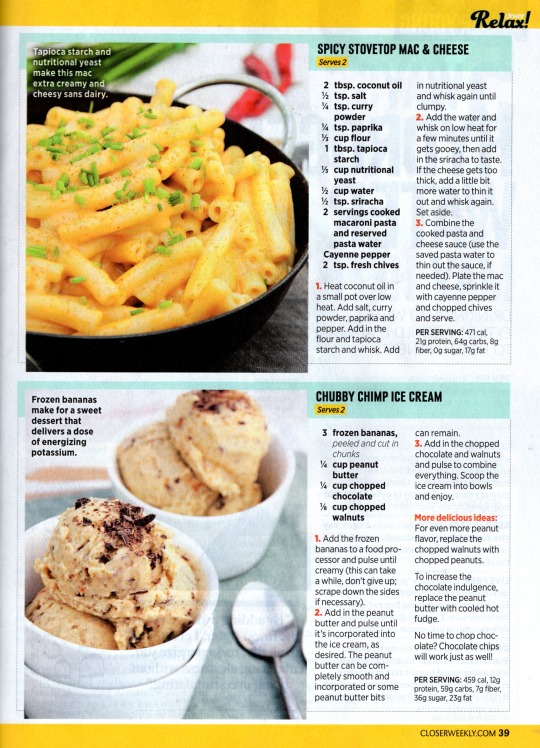
Page 40: 5 ways hydrogen water may help you
Page 42: Readers Ask -- Michelle Pfeiffer in Delta House, voice actor Larry Kenney, Whatever happened to the cast of The A-Team -- Mr. T, Dwight Schultz, Dirk Benedict, George Peppard
Page 43: Best Day of My Life -- Soledad O’Brien
Page 44: Who Am I? Jessica Lange, Ewan McGregor, Quentin Tarantino’s hobby is collecting TV board games, It Happened This Week
Page 45: Closer to the Heart
Page 46: Cameron Mathison -- a true Home & Family man
Page 50: Amy Adams and Darren Le Gallo showing the world their love
Page 52: Memories of Hee Haw on its 50th anniversary
Page 54: Vivien Leigh’s secret letters revealed
Page 56: 5 things you didn’t know about Samuel L. Jackson
Page 58: On the Move -- Nate Berkus
Page 60: The Big Picture -- Michael Caine and Alfie co-stars including Shelley Winters
Page 62: Style -- Sweater Dresses -- Debbie Matenopoulos, Olivia De Havilland circa 1938
Page 63: Julianne Moore
Page 64: The style of Leslie Mann
Page 66: Beauty -- The secret to soft lips -- Sandra Bullock
Page 68: Best Friends -- Susan Sarandon takes her beloved pup Penny everywhere including Stonehenge, Lisa Rinna doing goat yoga, Clark Gable in 1932 -- Please Adopt, Don’t Shop
Page 70: My Life in 10 Pictures -- Geena Davis
Page 72: Flashback -- Plaid coats worn by Claudette Colbert and Emma Roberts, Beauty masks worn by Lucille Ball and Drew Barrymore, Stars on skis -- Rita Hayworth and Rebel Wilson, Battle of the Sexes -- Billie Jean King and Bobby Riggs and Serena Williams and Roger Federer
#tabloids#gregory peck#carol burnett#bill murray#vegan#vegan recipes#vegan food#cravings made vegan#bianca haun#pulled jackfruit tacos#spicy stovetop mac & cheese#vegan tacos#vegan macaroni and cheese#chubby chimp ice cream#vegan ice cream
3 notes
·
View notes
Text
Charlie Bone Timeline: Pre-Series
Timeline of events before the series. Contains spoilers for all Charlie Bone books, including Henry and the Guardians of the Lost.
1800s
Circa 1804
· Marigold disappears through the Time Twister while playing hide-and-seek with her brother.
1833
· Maybelle Bloor is born to Cecilia and Septimus Bloor.
1835 or 1838
· Beatrice Bloor born to Cecilia and Septimus Bloor.
1840
· Bertram Babbington Bloor is born to Cecilia and Septimus Bloor.
1845
· Donatella da Vinci is born.
1850
· Yorath Yewbeam is born.
1850s
· Maybelle Bloor marries Lucius Raven.
1860
· Daniel Raven is born to Maybelle and Lucius Raven.
1862
· Vera Kuragina is born.
· Roland Raven is born to Maybelle and Lucius Raven.
1865
· Evangeline Raven is born to Maybelle and Lucius Raven.
· Septimus Bloor forges a will leaving everything he owns to his daughter Maybelle and her heirs. He dies soon after.
1870s
· Bertram Bloor marries Donatella Da Vinci.
1875
· Gideon Bloor born to Bertram and Donatella Bloor.
1876
· Gudrun Solensson born.
1884
· Manley Yewbeam born to Yorath and Vera Yewbeam.
1885
· Grace Bloor is born to Bertram and Donatella Bloor.
1896
· Lydia Raven is born to Daniel and Jane Raven.
1897
· Hugh Raven is born to Daniel and Jane Raven.
1899
· Ita Raven marries Simon Bone.
1900s
1900
· Yolanda Yewbeam is born in Yewbeam Castle to Yorath and Vera Yewbeam.
· Everard Raven is born to Roland and Ann Raven.
1902
· Ezekiel Bloor born to Gideon and Gudrun Bloor.
· Hilda Hansoff born.
1905
· Henry Yewbeam born to Grace and Manley Yewbeam.
1908
· Daphne Yewbeam born to Grace and Manley Yewbeam.
1910
· James Yewbeam born to Grace and Manley Yewbeam.
1912
· Solange Sourzac born.
1916
· Daphne Yewbeam dies of diphtheria in the winter of that year (January)
· Henry Yewbeam disappears while staying at Bloor’s Academy with his brother James. (January 12)
1918
· Manley Yewbeam is killed in battle during the Great War.
1921
· Yolanda inherits her father’s castle at age 21.
1920s
· Hugh Raven marries Sally Milne. Evangeline Raven gives the pearl-inlaid box to Sally on her wedding day.
1925
· Susan Raven born to Hugh and Sally Raven.
1930
· Bartholomew Bloor is born to Ezekiel and Hilda Bloor.
· Mary Chance is born.
1931
· Brutus Raven born to Hugh and Sally Raven.
1932
· Thomas Raven is born to Everard and Harriet Raven.
1934
· Timothy Raven is born to Everard and Harriet Raven.
1935
· Maisie Jones is born.
1937
· Grizelda Yewbeam is born to James and Solange Yewbeam.
· Monty Bone is born to Clara and Eamon Bone.
1940 or 1941
· Ankaret's family is killed during a bombing raid; Ankaret accidentally travels forward in time after looking into the Time Twister.
1942
· Lucretia Yewbeam is born to James and Solange Yewbeam.
1947
· Eustacia Yewbeam is born to James and Solange Yewbeam.
· Treasure is born.
1948
· Pearl is born.
1952
· Venetia Yewbeam is born to James and Solange Yewbeam.
1955
· Harold Bloor is born to Bartholomew and Mary Bloor.
1957
· February: Paton Yewbeam is born to James and Solange Yewbeam.
· Dorothy de Vere is born.
1961
· Grizelda Yewbeam marries Montague Bone.
1962
· Lyell Bone is born to Grizelda and Monty Bone.
· Titania/Miss Chrystal is born.
1962 or 1963
· A week before his death, Monty returns to his hometown of Neverfinding. Monty makes a will leaving all that he owns to his son Lyell. He also writes a letter to be read by Lyell when he turns eighteen.
· Monty Bone dies in a plane crash (possibly contrived by the Yewbeams and Bloors).
· Bartholomew Bloor disappears while mountain climbing in the Himalayas with friends; Mary dances herself to death. Bartholomew turns against his family and becomes an explorer.
1964
· During a stay at Yolanda’s castle, Solange falls and breaks her neck, Yolanda turns James’ four daughters against him, and James and Paton escape in fear for their lives.
· Hector Bittermouse causes some trouble with the Bloors (?)
· Lord Grimwald drowns Pearl and Treasure's sweethearts and family in revenge because they refused to marry him.
1965
· Grace Bloor dies at age eighty.
1967
· Amy Jones is born to Maisie and Mr Jones.
· Julia Ingledew is born.
1968
· Rufus Raven is born to Brutus and Maud Raven.
1970
· Ellen Raven is born.
1985
· Manfred Bloor is born to Harold and Dorothy Bloor.
· Asa Pike is born in the land of the Merromals.
1988
· Zelda Dobinski is born.
· Beth Strong is born.
1989
· Mr and Mrs Pike travel with Asa to the Red King’s city to live.
1990
· Lyell Bone elopes with Amy Jones to Mexico; they marry there.
· Tancred Torsson is born.
· Lysander Sage is born to Judge and Jessamine Sage.
1992
· Charlie Bone is born to Amy and Lyell Bone in the first week of January.
· Emma Tolly is born to Nancy and Mostyn Tolly (During fall or winter).
· Gabriel Silk is born to Cyrus and Mrs Silk.
· Naren Bloor is born to Chinese parents.
· Olivia Vertigo is born sometime in September.
· Fidelio Gunn is born to Chloe and Mr Gunn.
· Dagbert Endless is born to Lord Grimwald and a mermaid.
· Benjamin Brown is born to Mr and Mrs Brown in late October.
· Dorcas Loom is born.
1993
· Charlie turns one in the first week of January.
· Bartholomew returns to the city to visit his family, who refuse to acknowledge him. Lyell and Bartholomew become friends, and they go mountain climbing together.
· Idith and Inez Branko are born to Bogdan and Natalia Branko.
· Joshua Tilpin is born to Matthew and Titania Tilpin.
Sometime between 1990 and 1994
· Rufus entrusts Lyell with the box containing Maybelle’s will.
· Rufus and Ellen marry.
1994
· Charlie turns two in the first week of January.
· Nancy Tolly dies from illness just before Emma’s second birthday; a few days later Mostyn decides to give Emma away. (during fall or winter).
· Lyell disappears while trying to stop Emma Tolly’s abduction. (during fall or winter).
1995
· Billy Raven is born to Rufus and Ellen Raven on May 4.
1996
· Rufus and Ellen die in a contrived car accident; Billy is sent to live with an apathetic aunt.
· Christopher Crowquill is framed as a robber and sent to prison for seven years.
· Naren’s parents die in a flood; Naren is adopted by Bartholomew and Meng Bloor.
1997
· Miranda Shellhorn is born to Arthur Shellhorn.
· Charlie starts school.
· Charlie and Benjamin become friends.
1998
· Dorothy Bloor tries to leave Bloor's Academy forever; her violin hand is crushed by Manfred in the attempt and cursed by Ezekiel to never work again. Losing all hope, Dorothy becomes 'the Dark Lady'.
· Lucy comes out of the Time Twister into the Littles' House.
1999
· Eric Shellhorn is born to Arthur Shellhorn.
· Una Onimous is born.
· Dr Tolly asks for Emma to be returned to him; he is refused.
2000s
2001
· May 4: Billy’s endowment is revealed, and he is sent to live in Bloor’s Academy.
· Tancred Torsson starts school at Bloor's Academy.
· Ollie Sparks disappears in the old part of the Academy for three days. Cook throws a feast for him, and soon after he leaves the school. However, he disappears while going to get orange juice at the train station (or so Matron Yewbeam says).
2002
· Charlie turns ten in the first week of January.
· Emma turns ten between January and October.
8 notes
·
View notes
Text

Charlie Chaplin with French car manufacturer André Citroën and his family, St. Moritz circa January 1932.
15 notes
·
View notes
Photo

A flooded intersection [not far from USC] at Vermont Avenue and Adams Boulevard circa January 1932. ___________________________________________________ DO YOU KNOW A PLACE IN LOS ANGELES THAT OFTEN FLOODS DURING RAIN? PLEASE LEAVE THE LOCATION IN THE COMMENTS! THANKS IN ADVANCE! ___________________________________________________ #belowla #mtb #old #losangeles #urbanphotography #losangeleshistory #flood #flooding #floodcontrol #vintage #california #naturaldisaster #stormdrain #civilengineer #cityofangels #subdivision #oldphoto #straightouttacompton #urbex #losangelesriver #lariver #frogtown #urbanexploration #water #mountianbike #compton #mountainbiking #fixie #history #bmx (at University Park, Los Angeles) https://www.instagram.com/p/B7ZJHALHs7n/?igshid=3mqno84nfmph
#belowla#mtb#old#losangeles#urbanphotography#losangeleshistory#flood#flooding#floodcontrol#vintage#california#naturaldisaster#stormdrain#civilengineer#cityofangels#subdivision#oldphoto#straightouttacompton#urbex#losangelesriver#lariver#frogtown#urbanexploration#water#mountianbike#compton#mountainbiking#fixie#history#bmx
0 notes
Text
Materials used in Sept. 17 session in Manuscripts and Archives
Links from collection titles below lead to the online finding aid for each collection in Archives at Yale.
From Divinity Library Special Collections
Miscellaneous Personal Papers Collection (RG 30) - William Whiting Borden (Yale College Class of 1909) was a founder of the Yale Hope Mission, and served as a traveling secretary for the SVM. He went to Cairo, Egypt, to study Islam and Arabic in preparation for working among the Muslims in China, and died there in 1913.
Box 120, folder 10: Correspondence and other material related to Borden’s work with the Student Volunteer Movement for Foreign Missions, 1911-1913.
Student Volunteer Movement for Foreign Mission Records (RG 42) - The Student Volunteer Movement for Foreign Missions (SVM) was an organization that sought to recruit college and university students in the United States for missionary service abroad. Records document the activities of the SVM and provide valuable information on various aspects of American religious life during the period 1886-1964, as well as conditions on American college and university campuses.
Series I, Box 26, folder 14: Application blanks, Albro-Aldridge, circa 1902-1932.
Series I, Box 27, folder 22: Application blanks, Allenby-Allison, circa 1890-1948.
Series II, Box 138, folder 1379: Volunteer correspondence, Alb-Aldrich, circa 1920s-1930s.
Series II, Box 139, folder 1388: Volunteer correspondence, Anderson, A.-Anderson, C., circa 1920s-1930s.
John G. Magee Family Papers (RG 242) - Correspondence, writings, photographs, films, and other documentation of the life and work of John Gillespie Magee, his son John Gillespie Magee, Jr. and other family members. The Rev. John G. Magee (1884-1953), a graduate of Yale College (Class of 1906), served as a missionary to China under the Episcopal Church from 1912-1938. John G. Magee witnessed the Japanese invasion of Nanking (Nanjing) in December of 1937 and the subsequent Nanking Massacre.
Series III, Box 5, folder 2: Diary documenting missionary work in China, 18 September -28 December1916.
From Manuscripts and Archives
Dwight Hall, Yale University, Records (RU 47) - Correspondence, minutes of meetings, financial records, membership lists, program records, committee records, scrapbooks, subject files, conference records, publications and printed material, and related materials concerning the activities of Dwight Hall at Yale.
Accession 19ND-A-163, Box 9, folder 38a: Catalogs, articles, and other printed ephemera relating mainly to the Yale Mission in China, circa 1902-1909.
Yale-China Association Records (RU 232) - Records document the activities of the Yale-China Association in mainland China (1901-1951), Hong Kong (1951-present), and the United States (1901-present). They consist of administrative and policy files produced by the home office in New Haven, correspondence and memoranda written by staff members while serving in China, and administrative files and correspondence produced by the New Asia office in Hong Kong.
Series I, Box 14, folder 154: Early academic reports from Changsha, 1908-1912.
Series II, Box 32, folder 265: Hsiang Ya, curriculum reports, 1911-1920.
Series II, Box 54, folder 594: Yali, data on students and faculty, 1908-1924.
Series III, Box 57, folder 45: Chang, Fu Liang (Yale Sheffield Scientific School Class of 1913s) (Middle School staff), correspondence 1915-1921.
Series III, Box 62, folder 134: Farnam, Louise (Yale PhD 1916, MD 1920) (Medical staff), correspondence, 1929-1930.
Series III, Box 65, folder 182: Gage, Brownell (Yale College Class of 1898), correspondence, 1907.
Series III, Box 66, folder 204: Gage, Nina (Nursing staff), correspondence, 1904-1912.
Series III, Box 67, folder 228: Hail, William (Yale College Class of 1904) (Middle school teaching staff), correspondence, 1911-1912.
Series III, Box 107, folder 938: Yen, Fu-Chun (Yale MD 1909) (Medical staff), correspondence, 1909-1913.
Series VIII, Box 146: Scrapbook, “The Changsha Riots of 1910 ... Made up by Dickson H. Leavens at Kuling in the summer of 1910″.
Series VIII, Box 151, folder 2: Articles about Yale-in-China, 1910-1919.
Series IX, Box 154, folder 7: Photographs, Changsa campus, site before clearing, gateway, and panoramic views, early 20th century.
Series IX, Box 155, folder 22: Photographs, Changsha campus life - classes, daily routine, and study activity, early 20th century.
Series XIV, Box 191, folder 5: “History of the Class of 1917,” College of Yale-in-China, 1917.
John Lawrence Thurston Papers (MS 493) - General correspondence of Thurston (Yale College Class of 1898), missionary in China and active member of the Yale Foreign Missionary Society, makes up the major portion of these papers. The main topics are his work in China, including his interest in the Yale Missionary Band and the organization of the Yale Foreign Missionary Society.
Series II, Box 1, folder 29: Correspondence to Edward Bliss Reed, 1903.
Series II, Box 2, folder 39: Correspondence with the Yale Missionary Band, 1898-1903.
Warren Bartlett Seabury Papers (MS 790): Correspondence, essays and memorabilia of Seabury (Yale College Class of 1900), a missionary in China who helped plan and organize the Yale Foreign Missionary Society. Correspondence with his family (1904-1907) and reports on his work for the Society and the founding of the Yali Middle School is included.
Series I, Box 1, folder 3: Letters to family, January-May 1905.
0 notes
Photo


The "Garbo of the skies" 1930′s
Born 110 years ago today, 15th September 1910, Jean Gardner Batten was a New Zealand aviatrix. Born in Rotorua, she became the best-known New Zealander of the 1930s, internationally, by making a number of record-breaking solo flights across the world. She made the first-ever solo flight from England to New Zealand in 1936. In 1924 Batten was enrolled into a girls' boarding college in Remuera in Auckland where she studied ballet and piano. Though she was a gifted pianist, at age 18 she determined to become a pilot after the Australian pilot Charles Kingsford Smith took her for a flight in his Southern Cross airplane.
In 1929, she and her mother moved to England, to join the London Aeroplane Club. She took her first solo flight in 1930 and gained private and commercial licences by 1932, borrowing £500 from Fred Truman, a New Zealand pilot serving in the Royal Air Force who wanted to marry her, to fund the 100 hours flying time required. After completing her "B" license in December 1932, she left Truman and turned to Victor Dorée, who borrowed £400 from his mother to buy Batten a Gipsy Moth biplane. According to NZ History Online, "Raising money by taking advantage of her relationships with men was a theme that continued throughout her flying career. In May 1934, Batten successfully flew solo from England to Australia in the Gipsy Moth. Her trip of 14 days and 22 hours beat the existing England-to-Australia record of English aviatrix Amy Johnson by over four days. For this achievement and for subsequent record-breaking flights, she was awarded the Harmon Trophy three times (1935, 1936, 1937).
After her first Australia flight Batten bought a Percival Gull Six monoplane, G-ADPR, which was named Jean. In 1935 she set a world record flying from England to Brazil in the Percival Gull, for which she was presented the Order of the Southern Cross, the first person other than Royalty to be so honoured. In 1936 she set another world record with a solo flight from England to New Zealand. At her birthplace of Rotorua she was honored by local Māori, as she had been after the 1934 journey. She was given a chief’s feather cloak and given the title Hine-o-te-Rangi – "Daughter of the Skies". Batten was created Commander of the Order of the British Empire (CBE) in 1936, and she was also given the Cross of Chevalier of the French Legion of Honour that year. Also in 1936, for the second successive year, Batten was again awarded the Royal Aero Club's Britannia Trophy for most meritorious performance in aviation during the previous year. In 1937 she received the Gold Medal of the Royal Aero Club
World War II ended Batten's flying adventures. Her Gull was commissioned to active service and Batten was not permitted to fly it. During the war she was involved in campaigns giving lectures in England to raise money for guns and aeroplanes, but her flying days were over. After the war she retired from public life except for a few anniversary appearances. Batten became a recluse and lived in several places around the world with her mother until her mother's death in 1965. In 1977 she was guest of honour at the opening of the Aviation Pioneers Pavilion at Auckland's Museum of Transport and Technology, after which she returned to her home in Spain. In 1982 she was bitten by a dog on the island of Majorca. She refused treatment and the wound became infected. She died alone in a hotel on Majorca, from complications from the dog bite, and was buried on 22 January 1983.
These are my colourised versions of: Jean alongside her aeroplane, circa 1934, and a half-plate glass negative by Bassano Ltd, 29th November 1937
Restoring Your Past … Website Restoring Your Past … on Facebook
#aviatrix#pilot#solo flight#flight#flying#aviation#aeroplane#colourisation#colourised#restored#restoration#photo restoration#restoring old photos
0 notes
Text
From the Guns.com Warehouse: A Pile of Colt Gold Cups (PHOTOS)
What’s not to like about a Colt Gold Cup? (Photos: Richard Taylor/Guns.com)
An absolute classic offshoot of the standard M1911, the Colt Gold Cup series are iconic match pistols, and we have several up for grabs from the Guns.com warehouse.
John Moses Browning’s celebrated 1911 design was adopted by the U.S. military just in time for World War I and soon after Colt began to respond to feedback to tweak the gun for further use. In January 1932, Colt responded to the common fine tuning done to service pistols by military marksmen at the National Match competitions in Camp Perry by introducing the National Match series of accurized 1911s that offered upgrades such as hand-fitted internals, match barrels, checked triggers and mainspring housings and adjustable sights. This model proved popular until it was suspended in 1942 due to the pressing needs of World War II.
In 1957, Colt rebooted the concept as the “Gold Cup National Match” line and has retained the terminology ever since. Fundamentally, these guns have been the benchmark for right-out-of-the-box competition pistols for more than a half-decade with Colt long describing them as “the finest shooting semi-automatic in the world.” With that being said, many have also turned to the reliable all-steel longslide for personal protection and in the good old days when the wheel gun was king for law enforcement, it was not uncommon for members of LE shooting teams to carry their otherwise competition NM 1911s for everyday use.
Originally introduced with the square-bladed Colt Accro adjustable rear sight — which was later changed out as the series progressed, the guns featured slanted serrations on the slide as well as a grooved 7/16-inch flat rib in the 12-o’clock position, the latter feature giving the gun a distinctive “flat-top” appearance. Other improvements include a flat mainspring housing, larger ejection port and several minor internal differences from the standard GI 1911.
Our current selection of Gold Cups that is up for grabs from our extensive gun library covers a wide range of the gun’s production history, covering about a 30-year range.
This MK IV Series 70 Colt Gold Cup National Match from 1983 and includes factory Elliason rear sights, an adjustable trigger, and a beautiful finish for its age. It comes with its original box and paperwork. Colt stopped producing this model in 1983.
This stainless 80 Series Colt Gold Cup hails from 1993 and has wraparound grips
This Colt Gold Cup Trophy is a 1999-vintage gun. The Trophy series started in 1997 and this example includes Elliason rear sights and a wraparound grip. Of note, this beautiful Colt is currently just $999.
A more modern gun, this slick circa 2013 Series 80 Colt MK IV Gold Cup National Match “round top” has imitation pearl Colt grips and a skeletonized trigger.
This certified gun still has the original Colt rubber grips as well as an extra mainspring in its original factory case.
This Gold Cup National Match, of recent manufacture, is one of Colt’s Series 70 O5870A1 style flat tops, a more retro styling that Colt has been going with in recent years.
For home defense, competition use or sheer collectability, it is hard to beat a vintage Colt Gold Cup 1911.
We always have several Gold Cups on hand, with our current selection ranging across nearly a four-decade span of the type’s construction.
However, for those who would like to go with something new and take it from there, Colt still makes the Gold Cup line in both 70 and 80 series and Guns.com can help you out with one of those bad boys as well. Check out the video of the new stainless 70 Series Gold Cup Trophy we caught up a while back.
youtube
The post From the Guns.com Warehouse: A Pile of Colt Gold Cups (PHOTOS) appeared first on Guns.com.
from Guns.com http://bit.ly/30zukGe from Blogger http://bit.ly/2WkZxxy
0 notes
